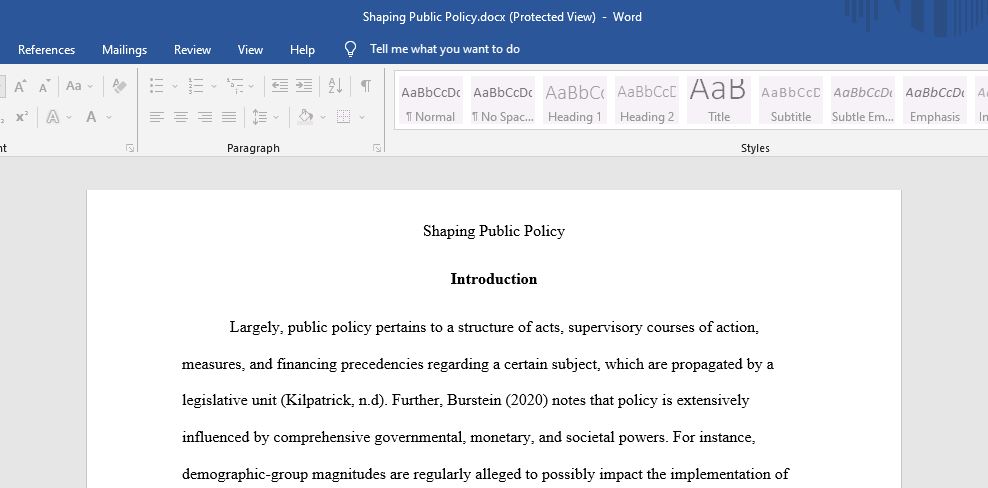Discuss Shaping Public Policy.
Clothes make the poor invisible…. America has the best-dressed poverty the world has ever known.”
— Michael Harrington
Public policy is how government, at the federal, state, and local levels address public concerns. Public policy can be understood through the following characteristics:
- Public policy responds to a perceived concern. The following concerns could be political, social, economic, environmental, etc.
- Public policy solutions are mostly addressed through legislation or regulation.
- Public policy is made at the behest of the people.
- Public policy is typically an ongoing process.
Political, social, and economic factors shape public policy.
- Political factors:
- Constitution, federalism, federal, state, and local governments, government officials, elections, political affiliations, etc.
- Social factors:
- Demographics, wealth, religion, education, national versus regional concerns, urban versus rural concerns, etc.
- Economic factors:
- State of the economy, budgetary policies/priorities, etc.
An example of how political, social, and economic factors shaped public policy is Medicaid, a government program that provides health insurance to low income and disabled people. The passing of Medicaid legislation was due to civic engagement, public opinion, social and economic rationales, and government involvement.
In 1962, Michael Harrington, a political activist and author, published a best-selling book, The Other America: Poverty in the United States. Harrington argued that in contrast to the growth of the middle class during the late 50s and early 60s there were still many Americans living in abject poverty. Harrington lamented how “…the poor are invisible,” and subject to a “poverty of culture.” Thus, it was the job of society to “help them before they can help themselves.” (Isserman, 2015, p. 107)
Harrington’s book ignited a mostly compassionate response from Americans. President Johnson, who was humbly raised in south Texas, was already deeply sympathetic to the plight of the poor. With public opinion on his side, President Johnson asked Congress to pass a comprehensive set of legislation, coined, the Good Society. The very focus on this “Second New Deal” was a war on poverty. Part and parcel of this legislation were Medicare and Medicaid.
On July 30, 1965 President Lyndon Johnson signed the Social Security Amendment of 1965 into law. Provisions of this law included Medicaid and Medicare. Unlike Medicare that provides health insurance to people age 65 and over, Medicaid provides health insurance to low income and disabled people. Medicaid is jointly funded by the federal and individual state governments. Although each state must follow certain mandatory guidelines, states are able to individually determine eligibility, services, and payments. As a result, Medicaid coverage varies from state to state.
Medicaid saw a dramatic increase in coverage when Congress passed the 2010 Patient Protection and Affordable Care Act (Obamacare). This law greatly expanded those eligible for coverage and the federal government pledged to almost entirely fund expanded coverage. However, due to the Supreme Court Case, NFIB v. Serbelius, states now have a choice in the matter. Each state can reject this, expanded coverage and keep their state’s Medicaid program at the previous parameters. As a result of federal and state health care policies, 32 states expanded coverage and 18 states declined the expanded coverage. This is important because today one out of five Americans receive some sort of Medicaid coverage.
Write a 400-word essay in which you include:
- An introduction.
- Select a specific example of public policy from one of the following fields:
- Economic policy
- An example of economic policy is U.S. budget deficit spending.
- Education policy
- An example of education policy is the implementation of national education standards.
- Environmental policy
- An example of environmental policy is the Clean Air Act.
- Foreign policy
- An example of foreign policy is how we conduct trade with other countries.
- Healthcare policy
- An example of healthcare policy is the Affordable Care Act (Obamacare)
- Welfare policy
- An example of welfare policy is Temporary Assistance for Needy Families (TANF).
- Provide a summary of this public policy.
- Economic policy
- Explain how three different factors shaped this public policy.
- How do political factors shape this public policy?
- Support your responses with at least one specific referenced example.
- How do social factors shape this public policy?
- Support your responses with at least one specific referenced example.
- How do economic factors shape this public policy?
- Support your responses with at least one specific referenced example.
- Support your examples with information from the text and at least two, additional academic sources.
- A conclusion.
- Correct grammar and syntax.
- APA format.
- How do political factors shape this public policy?
REFERENCES
Isserman, M., & Kazin, M. (2015). America divided: The Civil War of the 1960s. New York: Oxford University Press.
Program History. (n.d.). Retrieved from https://www.medicaid.gov/about-us/program-history/…
Answer preview:

word limit:445
